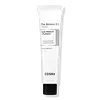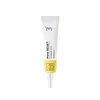What's inside
What's inside
 Key Ingredients
Key Ingredients

 Benefits
Benefits

 Concerns
Concerns

 Ingredients Side-by-side
Ingredients Side-by-side

Water
Skin ConditioningCaprylic/Capric Triglyceride
MaskingPropanediol
SolventGlycerin
HumectantTocopheryl Acetate
AntioxidantCetearyl Alcohol
EmollientButyrospermum Parkii Butter
Skin ConditioningPanthenol
Skin ConditioningTrehalose
HumectantGlycine Soja Oil
EmollientAmmonium Acryloyldimethyltaurate/Vp Copolymer
Dimethicone
EmollientGlyceryl Polymethacrylate
Helianthus Annuus Seed Oil
EmollientPolyglyceryl-10 Stearate
Skin ConditioningHydrogenated Lecithin
EmulsifyingHydroxyethyl Acrylate/Sodium Acryloyldimethyl Taurate Copolymer
Emulsion StabilisingCarbomer
Emulsion StabilisingTromethamine
BufferingGlyceryl Stearate
EmollientPolysilicone-11
Sodium Sulfite
PreservativeTocopherol
AntioxidantDaucus Carota Sativa Root Extract
Skin ConditioningAllantoin
Skin ConditioningGlyceryl Caprylate
EmollientOryza Sativa Bran Wax
Skin ConditioningRetinol
Skin ConditioningTocotrienols
Skin ConditioningStearic Acid
CleansingPolyglyceryl-3 Methylglucose Distearate
EmulsifyingPalmitic Acid
EmollientDisodium EDTA
Ethylhexylglycerin
Skin ConditioningAdenosine
Skin ConditioningSorbitan Isostearate
EmulsifyingElaeis Guineensis Oil
EmollientBHT
AntioxidantBeta-Carotene
Skin ConditioningMyristic Acid
CleansingLauric Acid
Cleansing3-O-Ethyl Ascorbic Acid
Skin ConditioningAscorbic Acid
AntioxidantGlutathione
Limnanthes Alba Seed Oil
Skin ConditioningSodium Hyaluronate
Humectant1,2-Hexanediol
Skin ConditioningHydrolyzed Hyaluronic Acid
HumectantSodium Hyaluronate Crosspolymer
HumectantHyaluronic Acid
HumectantSodium Acetylated Hyaluronate
HumectantWater, Caprylic/Capric Triglyceride, Propanediol, Glycerin, Tocopheryl Acetate, Cetearyl Alcohol, Butyrospermum Parkii Butter, Panthenol, Trehalose, Glycine Soja Oil, Ammonium Acryloyldimethyltaurate/Vp Copolymer, Dimethicone, Glyceryl Polymethacrylate, Helianthus Annuus Seed Oil, Polyglyceryl-10 Stearate, Hydrogenated Lecithin, Hydroxyethyl Acrylate/Sodium Acryloyldimethyl Taurate Copolymer, Carbomer, Tromethamine, Glyceryl Stearate, Polysilicone-11, Sodium Sulfite, Tocopherol, Daucus Carota Sativa Root Extract, Allantoin, Glyceryl Caprylate, Oryza Sativa Bran Wax, Retinol, Tocotrienols, Stearic Acid, Polyglyceryl-3 Methylglucose Distearate, Palmitic Acid, Disodium EDTA, Ethylhexylglycerin, Adenosine, Sorbitan Isostearate, Elaeis Guineensis Oil, BHT, Beta-Carotene, Myristic Acid, Lauric Acid, 3-O-Ethyl Ascorbic Acid, Ascorbic Acid, Glutathione, Limnanthes Alba Seed Oil, Sodium Hyaluronate, 1,2-Hexanediol, Hydrolyzed Hyaluronic Acid, Sodium Hyaluronate Crosspolymer, Hyaluronic Acid, Sodium Acetylated Hyaluronate
Water
Skin ConditioningMethylpropanediol
SolventNiacinamide
SmoothingDimethicone/Vinyl Dimethicone Crosspolymer
Skin ConditioningGlycerin
HumectantHdi/PPG/Polycaprolactone Crosspolymer
1,2-Hexanediol
Skin ConditioningPentylene Glycol
Skin ConditioningLecithin
EmollientChondrus Crispus Extract
Skin ConditioningSaccharum Officinarum Extract
MoisturisingTheobroma Cacao Seed Extract
AntioxidantGlycine Soja Oil
EmollientMelia Azadirachta Flower Extract
Skin ConditioningOcimum Sanctum Leaf Extract
Skin ConditioningMelia Azadirachta Leaf Extract
Skin ConditioningCurcuma Longa Root Extract
MaskingCorallina Officinalis Extract
Skin ConditioningPullulan
Polyacrylate Crosspolymer-6
Emulsion StabilisingPanthenol
Skin ConditioningSilybin
Skin ConditioningTocopherol
AntioxidantAcrylates/C10-30 Alkyl Acrylate Crosspolymer
Emulsion StabilisingCaprylyl Glycol
EmollientDextrin
AbsorbentTromethamine
BufferingEthylhexylglycerin
Skin ConditioningAdenosine
Skin ConditioningSilica
AbrasiveSodium Phytate
Retinol
Skin ConditioningSodium Dilauramidoglutamide Lysine
HumectantIsoceteth-10
EmulsifyingIsoceteth-25
EmulsifyingCaprylic/Capric Triglyceride
MaskingCholesterol
EmollientUbiquinone
AntioxidantZinc PCA
HumectantPhospholipids
Skin ConditioningCeramide NP
Skin ConditioningArginine
MaskingPhytosterols
Skin ConditioningBHT
AntioxidantPhenoxyethanol
PreservativeWater, Methylpropanediol, Niacinamide, Dimethicone/Vinyl Dimethicone Crosspolymer, Glycerin, Hdi/PPG/Polycaprolactone Crosspolymer, 1,2-Hexanediol, Pentylene Glycol, Lecithin, Chondrus Crispus Extract, Saccharum Officinarum Extract, Theobroma Cacao Seed Extract, Glycine Soja Oil, Melia Azadirachta Flower Extract, Ocimum Sanctum Leaf Extract, Melia Azadirachta Leaf Extract, Curcuma Longa Root Extract, Corallina Officinalis Extract, Pullulan, Polyacrylate Crosspolymer-6, Panthenol, Silybin, Tocopherol, Acrylates/C10-30 Alkyl Acrylate Crosspolymer, Caprylyl Glycol, Dextrin, Tromethamine, Ethylhexylglycerin, Adenosine, Silica, Sodium Phytate, Retinol, Sodium Dilauramidoglutamide Lysine, Isoceteth-10, Isoceteth-25, Caprylic/Capric Triglyceride, Cholesterol, Ubiquinone, Zinc PCA, Phospholipids, Ceramide NP, Arginine, Phytosterols, BHT, Phenoxyethanol
 Reviews
Reviews

Ingredients Explained
These ingredients are found in both products.
Ingredients higher up in an ingredient list are typically present in a larger amount.
1,2-Hexanediol is a synthetic liquid and another multi-functional powerhouse.
It is a:
- Humectant, drawing moisture into the skin
- Emollient, helping to soften skin
- Solvent, dispersing and stabilizing formulas
- Preservative booster, enhancing the antimicrobial activity of other preservatives
Adenosine is in every living organism. It is one of four components in nucleic acids that helps store our DNA.
Adenosine has many benefits when used. These benefits include hydrating the skin, smoothing skin, and reducing wrinkles. Once applied, adenosine increases collagen production. It also helps with improving firmness and tissue repair.
Studies have found adenosine may also help with wound healing.
In skincare products, Adenosine is usually derived from yeast.
Learn more about AdenosineBHT is a synthetic antioxidant and preservative.
As an antioxidant, it helps your body fight off free-radicals. Free-radicals are molecules that may damage your skin cells.
As a preservative, it is used to stabilize products and prevent them from degrading. Specifically, BHT prevents degradation from oxidation.
The concerns related to BHT come from oral studies; this ingredient is currently allowed for use by both the FDA and EU.
However, it was recently restricted for use in the UK as of April 2024.
Learn more about BHTThis ingredient is an emollient, solvent, and texture enhancer. It is considered a skin-softener by helping the skin prevent moisture loss.
It helps thicken a product's formula and makes it easier to spread by dissolving clumping compounds.
Caprylic Triglyceride is made by combining glycerin with coconut oil, forming a clear liquid.
While there is an assumption Caprylic Triglyceride can clog pores due to it being derived from coconut oil, there is no research supporting this.
Learn more about Caprylic/Capric TriglycerideEthylhexylglycerin (we can't pronounce this either) is commonly used as a preservative and skin softener. It is derived from glyceryl.
You might see Ethylhexylglycerin often paired with other preservatives such as phenoxyethanol. Ethylhexylglycerin has been found to increase the effectiveness of these other preservatives.
Glycerin is already naturally found in your skin. It helps moisturize and protect your skin.
A study from 2016 found glycerin to be more effective as a humectant than AHAs and hyaluronic acid.
As a humectant, it helps the skin stay hydrated by pulling moisture to your skin. The low molecular weight of glycerin allows it to pull moisture into the deeper layers of your skin.
Hydrated skin improves your skin barrier; Your skin barrier helps protect against irritants and bacteria.
Glycerin has also been found to have antimicrobial and antiviral properties. Due to these properties, glycerin is often used in wound and burn treatments.
In cosmetics, glycerin is usually derived from plants such as soybean or palm. However, it can also be sourced from animals, such as tallow or animal fat.
This ingredient is organic, colorless, odorless, and non-toxic.
Glycerin is the name for this ingredient in American English. British English uses Glycerol/Glycerine.
Learn more about GlycerinGlycine Soja Oil comes from the soybean. Glycine Soja is native to eastern Asia.
Soybean oil is an emollient. It is rich in antioxidants and fatty acids including palmitic, stearic, oleic, and linoleic acids.
As an emollient, the fatty acids in soybean oil helps keep your skin soft and hydrated. It does so by creating a film on top that traps moisture in.
Soybean oil is also rich in vitamin E, a potent antioxidant. Vitamin E is also anti-inflammatory and provides a soothing effect.
Studies show soy may help fade hyperpigmentation from UVB. It does so by disrupting the melanin process from UVB induced skin inflammation.
This ingredient may not be malassezia folliculitis, or fungal-acne, safe.
Soybeans are rich in proteins and are part of the legume family. Foods made with soybeans include tofu, soymilk, edamame, miso, and soy sauce.
Learn more about Glycine Soja OilPanthenol is a common ingredient that helps hydrate and soothe the skin. It is found naturally in our skin and hair.
There are two forms of panthenol: D and L.
D-panthenol is also known as dexpanthenol. Most cosmetics use dexpanthenol or a mixture of D and L-panthenol.
Panthenol is famous due to its ability to go deeper into the skin's layers. Using this ingredient has numerous pros (and no cons):
Like hyaluronic acid, panthenol is a humectant. Humectants are able to bind and hold large amounts of water to keep skin hydrated.
This ingredient works well for wound healing. It works by increasing tissue in the wound and helps close open wounds.
Once oxidized, panthenol converts to pantothenic acid. Panthothenic acid is found in all living cells.
This ingredient is also referred to as pro-vitamin B5.
Learn more about PanthenolRetinol is a gold-standard ingredient for anti-aging. It is a form of Vitamin A and belongs to the class of retinoids that also includes tretinoin.
Why is retinol famous?
It has the most scientific studies backing up its skin benefits out of all the non-prescription ingredients.
Retinol is proven to:
This is why retinol is effective at removing wrinkles, fading dark spots, treating acne, and reducing the appearance of pores.
Studies show retinol is less effective when exposed to UV. Be sure to look for appropriate packaging to keep your retinol potent (similar to Vitamin C).
Using retinol or any retinoids will increase sun-sensitivity in the first few months. Though studies show retinoids increase your skin's natural SPF with continuous use, it is best to always wear sunscreen and sun-protection.
We recommend speaking with a medical professional about using this ingredient during pregnancy.
Retinol may cause irritation in some people, so be sure to patch test. Experts recommend 'ramping up' retinol use: start using this ingredient once a week and work up to using it daily.
Read about Tretinoin
Learn more about RetinolTocopherol (also known as Vitamin E) is a common antioxidant used to help protect the skin from free-radicals and strengthen the skin barrier. It's also fat soluble - this means our skin is great at absorbing it.
Vitamin E also helps keep your natural skin lipids healthy. Your lipid skin barrier naturally consists of lipids, ceramides, and fatty acids. Vitamin E offers extra protection for your skin’s lipid barrier, keeping your skin healthy and nourished.
Another benefit is a bit of UV protection. Vitamin E helps reduce the damage caused by UVB rays. (It should not replace your sunscreen). Combining it with Vitamin C can decrease sunburned cells and hyperpigmentation after UV exposure.
You might have noticed Vitamin E + C often paired together. This is because it is great at stabilizing Vitamin C. Using the two together helps increase the effectiveness of both ingredients.
There are often claims that Vitamin E can reduce/prevent scarring, but these claims haven't been confirmed by scientific research.
Learn more about TocopherolTromethamine helps balance the pH and improve the texture of a product. It is synthetically created.
As an emulsifier, Tromethamine prevents oil and water ingredients from separating. This helps stabilize the product and elongate a product's shelf life. Tromethamine also makes a product thicker.
Tromethamine helps balance the pH level of a product. Normal pH level of skin is slightly acidic (~4.75-5.5). The acidity of our skin is maintained by our glands and skin biome. Being slightly acidic allows our skin to create an "acid mantle". This acid mantle is a thin barrier that protects our skin from bacteria and contaminants.
Oral Tromethanmine is an anti-inflammatory drug but plays the role of masking, adding fragrance, and/or balancing pH in skincare.
1,3-Propanediol, 2-amino-2-(hydroxymethyl)-
Learn more about TromethamineWater. It's the most common cosmetic ingredient of all. You'll usually see it at the top of ingredient lists, meaning that it makes up the largest part of the product.
So why is it so popular? Water most often acts as a solvent - this means that it helps dissolve other ingredients into the formulation.
You'll also recognize water as that liquid we all need to stay alive. If you see this, drink a glass of water. Stay hydrated!
Learn more about Water